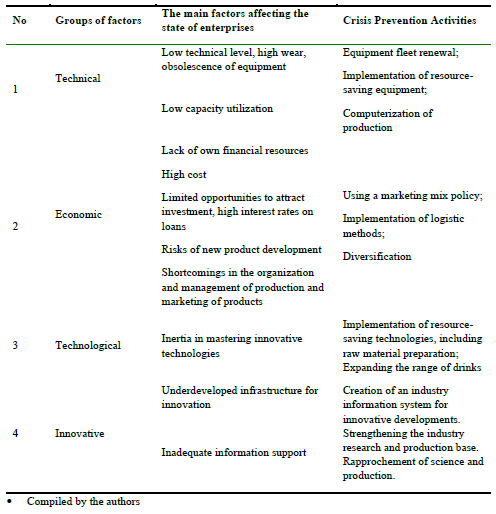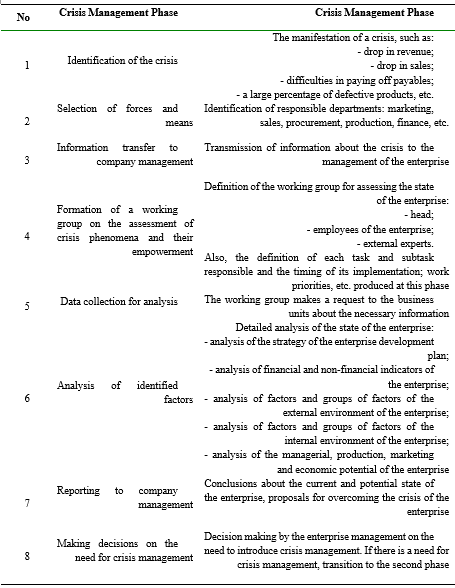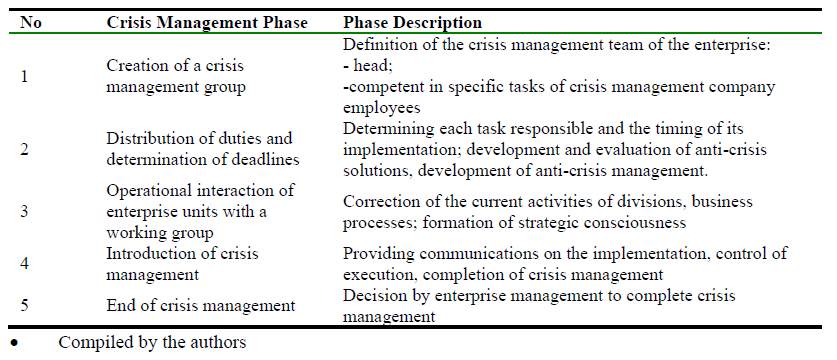Crisis Identification and Development of Crisis Management Algorithm in the Agricultural Sector
ABSTRACT
The efficiency of many enterprises has declined significantly in the current global crisis. Enterprise management is the management of joint activities of people, which consists of many problems. The primary tactical tasks for most business entities are “patching holes” (or a reactive form of management) and preventing bankruptcy. This approach does not allow to achieve sustainable operation of the enterprise in the long term. Therefore, the formation of an effective mechanism for managing enterprises is acquiring special significance in today's conditions. The crisis is characterized by many interrelated situations that increase the complexity and risk of management. The problem of evaluating the effectiveness of enterprises is still one of the most complex and intractable. The crisis is objectively characterized by many interrelated situations that increase the complexity and risk of management. The crisis state of the enterprise is particularly difficult in predicting the results of management actions, since the course of events can be changed by relatively small impacts. Based on this, the company should be able to analyze both its own interests and the interests of business partners with whom the company enters into economic relations. There is such a problem as low management competence in the agricultural sector. In this regard, the development of enterprises becomes an urgent problem. This can be achieved by forming a scientifically based algorithm of actions aimed at improving the position of enterprises in the market.
The subject of the study is the formation of a crisis identification system and the development of an enterprise crisis management algorithm. The theoretical and practical significance of solving problems associated with achieving sustainable development and functioning of enterprises determined the choice of goals, objectives, object and subject of this study. Based on the foregoing, the object of study is industrial (processing) agricultural enterprises.
The research task is to propose a set of measures to overcome the crisis in the processing industrial enterprise.
A set of measures has been proposed and justified to overcome the crisis in an industrial enterprise, which will help in managing the economic entity and the result of the implementation of this approach should be overcoming the crisis.
The proposed measures can be applied not only by industrial processing enterprises, but also by other economic entities.
keyword
strategy, crisis management, bankruptcy, analysis
Introduction
Industrial processing of agricultural products is one of the most capacious sectors of the Russian industry responsible for food security.
In modern market conditions, the fundamental for the effective development of the activities of any economic entities is to change the production management system through the widespread use of economic methods (Alborov, Kontsevaya, Klychova and Kuznetsovd, 2017). The main task of the management system is the development and implementation of management decisions (Ostaev, Klychova and Nekrasova, 2018). The optimality principle is important, which means that it is necessary to study the maximum of possible options for the execution of a managerial decision and choose those that would most fully ensure the achievement of goals, including in crisis situations (Ostaev, 2017).
Insufficient attention is paid to the functioning of crisis enterprises or those entering the phase of crisis functioning of enterprises (Alborov and Kontsevoy, 2016; Sheremet, 2009). In some studies, crisis management is presented as a self-sufficient mechanism (Khosiev, Ostaev, Kontsevoy, Suetin, Sokolov, Antonov and Suetin, 2019), while its role in the activities of industrial processing enterprises remains unsolved.
Literature review
In the conditions of the market Russian economy, the interest of participants in the economic process to reliable and objective information about business activity and the financial condition of the organization significantly increases. Broad scientific circles have actively studied the problem of predicting bankruptcy since the advent of the works of Beaver (1966) and Altman (1968).
The most popular foreign models of bankruptcy of enterprises in modern times are: “Financial Rations. Discriminant Analysis, and the Prediction of Corporate Bankruptcy” (Altman, 1968), “R. Lis’s Bankruptcy Forecasting Model (Great Britain, 1972)” (Edwards, 1996), “Forecasting company failure in the UK using discriminant analysis and financial ratio data” (Taffler, 1982), “G. Springate's Bankruptcy Forecasting Model (Canada, 1978)”, “D. Fulmer's Bankruptcy Forecasting Model (USA, 1984)” (Edwards, 1996); There are also models of Russian scientists R.S. Sayfulina and G.G. Kadykova (1996), N.N. Selezneva and A.F. Ionova (2001), A.V. Kolyshkin (2003) etc.
The algorithm for constructing all models of multiple discriminant analysis (MDA-models) is the same: a sample of bankrupt enterprises is formed; a sample of non-bankrupt enterprises is being formed; financial ratios for both groups are calculated; using the tools of multiple discriminant analysis (MDA), a regression equation is constructed that classifies all enterprises into bankrupt and non-bankrupt; the adequacy of the constructed model is checked.
In our opinion, the two and three-factor models constructed by the multivariate discriminant analysis method are not sufficiently accurate. More factors are needed. However, in our opinion, a large number of financial ratios is also a drawback of the model.
None of the models proposed by foreign scientists can objectively correspond to Russian economic conditions, domestic models also do not take into account the industry affiliation of the agro-industrial complex. We can conclude that it is necessary to supplement quantitative indicators with qualitative ones. It is also necessary, on the basis of foreign and domestic developed MDA models, to continue the development of models and methods for identifying the crisis, as well as the crisis management algorithm in the agro-industrial complex.
Methodology
The development of the global and national economies in modern conditions is characterized by multiple transitional processes, accompanied by both local and global crises (Endovitsky, Lyubushin, Babicheva and Zotova, 2019; Endovitsky and Durakova, 2018).
Volatility in both global and national markets has occurred in recent years. Organizations use different methods to ensure sustainable development by forecasting threats and managing risks in response to changes in the operating environment (Erokhin, Endovitsky, Bobryshev, Kulagina and Ivolga, 2019).
In many ways, the causes of the crisis in the functioning of agricultural production that are currently observed are due to the loss of control over ongoing processes (Molchan, Frantsisko, Ternavshchenko, Ostaev, Tinyakova and Markovina, 2020).
An important role in the development of an effective food security strategy is played by the study of global trends affecting the future of food security in the world and global experience in solving this problem (Frantsisko, Ternavshchenko, Molchan, Ostaev, Ovcharenko and Balashova, 2020).
The food production index was 104.9% in 2019 compared to 2018, and 110.8% in December 2019 compared to the corresponding period of the previous year (tables 1, 2) (Information on the socio-economic situation of Russia, 2019, Moscow https://gks.ru/storage/mediabank/oper-12-2019.pdf).
Table 1. Dynamics of food production in 2018.

Table 2. Dynamics of food production in 2019

The transition of farms to market rails at the end of the last century necessitated the adaptation of production and management mechanisms to the requirements of the external environment, which in the first place required the maintenance and strengthening of labor discipline, the independence and initiative of management in setting and solving current and future problems (Kondratiev, Ostaev, Osipov , Bogomolova, Nekrasova and Abasheva, 2020). At the same time, many economic entities under the influence of market business processes could not adapt to the current realities, or under the influence of certain factors, both internal and external, have signs of insolvency (bankruptcy) (Kontsevaya, 2017; Kontsevaya, Сhachotkin, Kostina and Khoruziy, 2019).
Table 3. Subjects of bankruptcy by industry.

In accordance with the objectives of the study, it is necessary to determine the criteria for the transition of an industrial (processing) enterprise to crisis management (Khoruzhy, Gupalova and Katkov, 2019; Molchan, Frantsisko, Ternavshchenko, Illaronova and Prokhorova, 2017). The following new concepts were introduced fundamentally for this: the transition point to crisis management and strategic management in the face of uncertainty and crisis in industrial processing enterprises.
“The point of transition to crisis management” is a point in time at which the resources of current management methods and private anti-crisis measures are exhausted, and the performance of the enterprise continues to deteriorate and continued operation of the enterprise using the management technologies used by it leads to a high risk of bankruptcy of the enterprise.
“Strategic management in the face of uncertainty and crisis of industrial processing enterprises” as an economic category is a set of economic relations that are formed and proceeding in the management system of an industrial processing enterprise in crisis conditions regarding the most complete, timely and high-quality distribution of available resources to achieve an economic output subject out of crisis.
One of the main factors affecting the functioning of industrial processing enterprises is various instruments of state and regional support (Ostaev, Khosiev, Nekrasova, Frantsisko, Markovina and Kubatieva, 2019).
Table 4. Factors that affect the financial condition of the company.

During the study, a descriptive method was used, which is a system of procedures for collecting, primary analysis and presentation of data and their characteristics.
Results and discussion
The algorithm for building a crisis management system can be represented as follows (Figure 1).
.PNG)
Figure 1. Algorithm for building a crisis management system (authoring).
Identification of the crisis is the determination of the factors of crisis formation and decision-making on the transition to crisis management of the enterprise.
The crisis management algorithm at the first phase is presented in table 5.
Table 5. The crisis management algorithm in the first phase.

The definition of crisis management tasks is the definition of goals, objectives, resources and terms (determination of the goals and objectives of crisis management of an industrial enterprise; determination of a list of capable solutions to problems of crisis management of an industrial enterprise; determination of resources for implementing crisis management of an industrial enterprise (human, financial, intellectual, technological, production, marketing, marketing, reputational); determination of the start and end dates of anti-crisis management Lenia industrial enterprise).
The implementation of crisis management is regulation, the selection of forces, means and those responsible (the establishment of the regulations for crisis management of an industrial enterprise; the selection of forces and means for the implementation of crisis management; the identification of those responsible for the implementation of crisis management; the phased implementation of crisis management of an industrial enterprise; periodic analysis of an enterprise's activities; performance monitoring crisis management of an industrial enterprise).
The completion of crisis management is testing, analysis and management (testing the results of the implementation of crisis management of an industrial enterprise; analysis of enterprise sustainability indicators; transition to crisis management of an industrial enterprise).
The entire algorithm presented should ensure the smooth operation of the crisis management system, which will later help the industrial (processing) enterprise either restore its normal state or identify problem areas in its activities. It is also assumed that this process should consist of two phases, which will include subparagraphs of the presented algorithm. The first phase will be the detection of threats and crisis phenomena at an industrial enterprise, their assessment, determination of further actions. At the second phase, the implementation and use of crisis management of the enterprise takes place.
At phase, one, corresponding to the first and second subparagraphs of the algorithm described above (table 5), the key organizational structure of this scheme should be a group of experts that assesses the state of the enterprise, created by management when crisis phenomena are detected in the enterprise. This group should ensure the collection, analysis and evaluation of data on the state of the enterprise, prepare conclusions disclosing the main causes and factors of the crisis in the enterprise, ensure the interaction of the enterprise units and environmental sources to solve these problems. The working group develops the concept of crisis management, interacts with management, which, on the basis of the data received, decides to introduce a crisis management system at the enterprise. After deciding on the introduction of a crisis management system, the enterprise should be organized as part of the second phase (table 6).
Table 6.The crisis management algorithm in the second phase.

Since activities to overcome the crisis must be operational, a number of actions must be carried out in parallel at the second phase, corresponding to subparagraphs 3 and 4. Also during anti-crisis measures, there is an operational interaction, changes in business processes and the restoration / formation of a stable corporate environment that meets the modern needs of the enterprise.
In order to improve internal financial control, it is necessary to develop a process, determine the frequency and responsible persons.
It is proposed to build the following internal control process in the crisis management system at the enterprise, which will ensure the normal functioning of the organization (table 7).
Table 7. Objects of control in crisis management and consolidation of responsibility.

Control is a universal mechanism and management function of an organization (Kontsevoi, Ermakov, Rylova, Leoshko and Safonova, 2020). The crisis management group interacts directly with the company’s management, providing periodic reporting and forecast information, provides communications at the enterprise to adjust current measures of the crisis management system. Qualification, interest in a positive result of crisis management and willingness to learn new competencies of enterprise management are of great importance in the success of crisis management. The implementation of crisis management can be complicated by the following reasons:
- the internal resources of the enterprise counteract anti-crisis measures, delaying or interrupting the implementation of anti-crisis management. This resistance can be attributed to: dissatisfaction and lack of staff motivation, accelerated depreciation of equipment in the event of forced production; instability of business processes at the phase of their reengineering;
- there is no practical experience in implementing crisis management, the company's management has only ideas about a project management methodology based on a theoretical study of standards;
- technical and managerial errors of management in the implementation of crisis management related to insufficient competencies in the field of management;
- there is no common understanding by management of the goals and objectives of crisis management in the enterprise;
- there are no relevant documents and formalized algorithms governing communications, the management hierarchy and the activities of the enterprise units.
Conclusions
The advantages of using the presented crisis management algorithm are:
- implementation of constant monitoring at various levels depending on the current situation and the facts of the detection of crisis phenomena and their scale, allowing timely identification of threats and development of appropriate countermeasures;
- the use mainly of the company's own resources in order to reduce the associated costs of monitoring and anti-crisis measures;
- a clear delineation and definition of personal responsibility and authority;
- a systematic approach to determining the phenomena and factors of the crisis, as well as in the development and implementation of anti-crisis programs due to the involvement of specialists and managers of various levels and activities in accordance with the directions of the sources of threats;
- increased control over the expenditure of funds and resources (material and labor) aimed at anti-crisis measures and methods for their more efficient use, due to the high-quality awareness of the involved specialists;
- increasing the efficiency of using the time factor in analyzing the situation and implementing anti-crisis measures;
- a qualitative increase in the level of systems and methods of internal communications.
The result of this approach should be to overcome the crisis (with the subsequent transition to the operational management of the organization), evaluate the effectiveness of anti-crisis measures, introduce a monitoring system for the manifestation of crisis phenomena at the enterprise.

